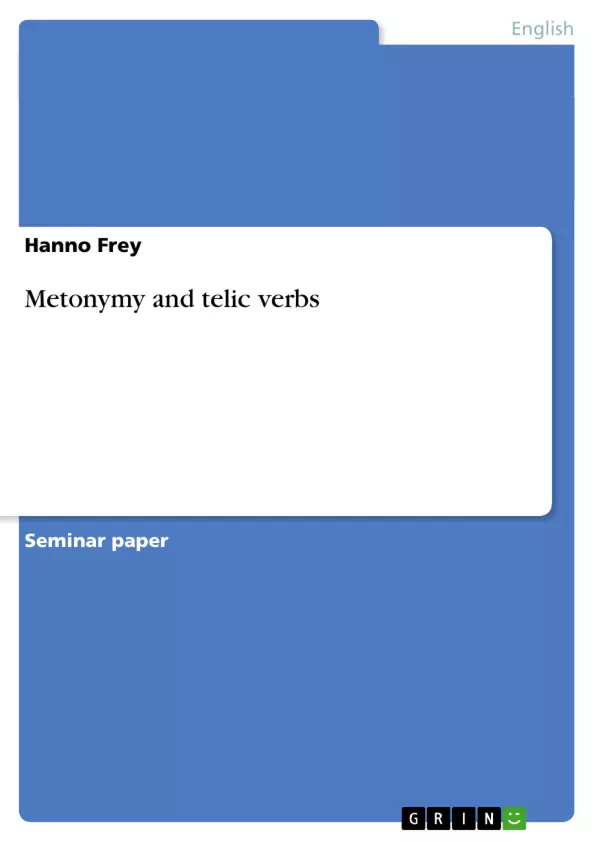For centuries, the study of metonymy and metaphor has been regarded purely a matter of style and rhetoric. In addition to that, research into metonymic relationship traditionally has been put only second to the phenomenon of metaphor. However, things have changed a little over the past decades. Especially after Lakoff/ Johnson had published their influential work on metaphor and conceptualization (“Metaphors we live by”, 1980) research into cognitive aspects of language gained more ground in linguistics. Deeper insight into the way we structure our perception of the world has led to the conclusion that both, metaphor and metonymy, must be regarded as cognitive phenomena. As such they illustrate the fact that “fundamental cognitive abilities and experientially derived cognitive models have direct and pervasive linguistic manifestations” (Langacker, 1993, p.1) and, conversely, that by ways of examining language we can analyse important aspects of the way our mind is structured. As for metonymy, the relationship between thought and language is characterised by the fact that “an expression that normally designs one entity is used instead to designate another, associated entity” (Langacker, 1993, p. 29). Crucial questions which spring from this assumption are: How and why do we understand metonymies? Which principles are involved in the process of creating and understanding metonymic expressions and why can we rely on them?1
In the following, I will answer these questions on the basis of Ronald W. Langacker´s essay “Reference-point Construction” (Langacker, 1993). I will apply Langacker´s theoretical notions to a rather specific area of language: telic verbs. By way of referring to a selection of telic verbs I will argue that the understanding of telic verbs relies on metonymy- a metonymy that is not included in the lists of metonymies developed by some well-known linguists (cf.: Fass, 1997, 461-469). The contents of my term paper is structured in three parts: First of all, I am going to exemplify Langacker´s theory about metonymic expressions. In a second step I will point out important characteristics of telic verbs. Finally, I will exemplify how the process of understanding telic verbs can be explained in terms of Langacker´s theory.
Inhaltsverzeichnis (Table of Contents)
- Introduction
- Metonymy
- Reference point construction
- Telic and atelic verbs
- What are telic verbs?
- Examples
- Conclusion
Zielsetzung und Themenschwerpunkte (Objectives and Key Themes)
This term paper explores the relationship between metonymy and telic verbs, drawing upon Ronald W. Langacker's theory of reference-point construction. It aims to demonstrate how the understanding of telic verbs relies on a specific type of metonymy that is not typically included in existing lists of metonymies.
- Metonymy as a cognitive phenomenon and its role in language.
- Langacker's theory of reference-point construction and its application to metonymy.
- The characteristics and understanding of telic verbs.
- The metonymic relationship between reference points and telic verbs.
- The cognitive processes involved in understanding metonymic expressions.
Zusammenfassung der Kapitel (Chapter Summaries)
- Introduction: This section provides an overview of the historical development of metonymy and metaphor studies, highlighting the growing recognition of their cognitive nature. It also introduces Langacker's theory of reference-point construction and its relevance to understanding metonymic expressions.
- Metonymy: This chapter defines metonymy as a phenomenon where an expression designates an associated entity, providing various examples and discussing their cognitive underpinnings. It delves into the concept of reference-point construction, explaining how the reference point serves as a mental link to the target entity.
- Telic and atelic verbs: This section defines telic verbs and presents examples of their usage. It explores the characteristics of these verbs and how they relate to the concept of reference-point construction.
Schlüsselwörter (Keywords)
This term paper focuses on the key concepts of metonymy, reference-point construction, telic verbs, and cognitive linguistics. It explores the cognitive mechanisms underlying the use and understanding of metonymic expressions, particularly in the context of telic verbs.
- Quote paper
- Hanno Frey (Author), 2002, Metonymy and telic verbs, Munich, GRIN Verlag, https://www.grin.com/document/16389



